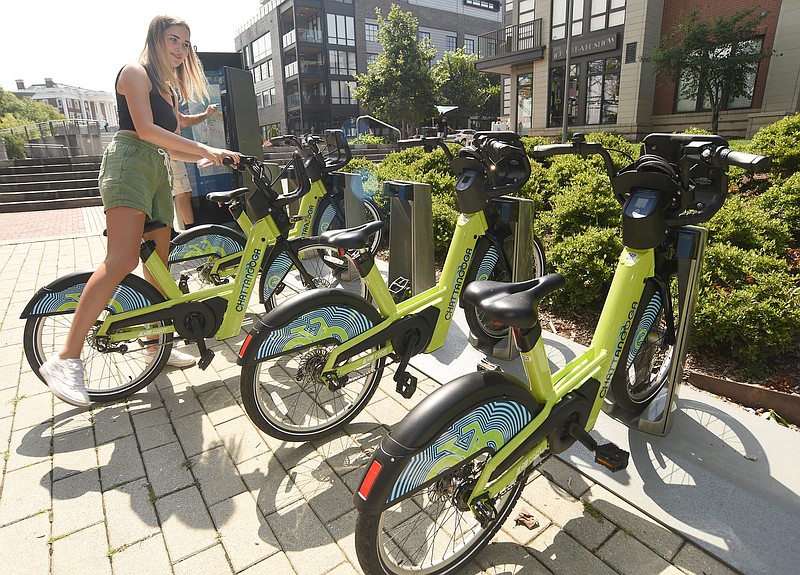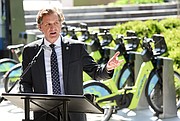On its 11th anniversary operating in the city, Bike Chattanooga has added 50 new electric bicycles, or e-bikes, to its bike-sharing fleet and opened a new bike docking station in North Chattanooga.
The new Hill City docking station is one of 43 stations, five of which charge the e-bikes. The newest charging station opened Thursday at the Walnut Street Plaza on the south side of the pedestrian bridge.
"Outdoor recreation and our green spaces and health and wellness are all kind of integral to the brand of Chattanooga, and our bike-sharing system is kind of the tip of the spear for that," Mayor Tim Kelly said during an event Thursday at the Walnut Street Plaza.
E-bikes operate similarly to mechanical bikes, Ben Taylor, deputy administrator for transportation for the city, said in a phone interview. Cyclists pedal e-bikes the same as a mechanical bike, but the acceleration is assisted by electricity, topping at 15 mph.
"There's no throttle or anything like that. It's just as you pedal the bike, you'll feel a boost. You'll feel the electric engine kick in, and it'll boost you up a little bit," Taylor said. "Basically, what it does is it will make the hilly terrain of Chattanooga all feel like you're biking on a flat road."
Taylor said it would be difficult to notice, unless you're cycling yourself, whether someone is riding an e-bike or a mechanical bike, as there is no loud noise associated with the acceleration. The primary difference, beyond the electric engine, is the bright fluorescent green color on the e-bikes.
Accounting for electric and mechanical bikes, there are 450 bikes total, with 105 being e-bikes. Since e-bikes were introduced in 2018, they've taken up a large percentage of total usage — over 30% annually each of the past three years.
Bike rides per year
— 2012: 11,606
— 2013: 45,180
— 2014: 51,250
— 2015: 55,904
— 2016: 55,240
— 2017: 57,493
— 2018: 53,271 (6.2% e-bike)
— 2019: 73,638 (27.1% e-bike)
— 2020: 88,645 (35.7% e-bike)
— 2021: 97,471 (32.5% e-bike)
— 2022: 90,756 (34.6% e-bike)
— Source: Shift Transit
Overall ridership has increased significantly since 2018 — up 70% from that year to 2022.
It's part of a larger national trend in bike-sharing since the onset of the pandemic in 2020.
Annual ridership in six large cities — New York City, Chicago, San Francisco, Boston, Washington D.C. and Jersey City — jumped 27% from 2019 to 2022, Bloomberg reported this week.
Bike Chattanooga, which is owned by the city, offers annual passes to paying members. Membership rates have fluctuated since the program started in 2012, but last year saw 1,134 members, the most since 2015.
Annual membership holders per year
— 2012: 102
— 2013: 592
— 2014: 328
— 2015: 1,392
— 2016: 724
— 2017: 545
— 2018: 557
— 2019: 808
— 2020: 851
— 2021: 996
— 2022: 1,134
— Source: Shift Transit
(READ MORE: US Bicycle Route System now runs through Chattanooga)
Offering an alternative to gas-powered vehicles, bike-sharing systems like Bike Chattanooga also make headway on curbing carbon emissions. According to Bike Chattanooga, the system offset 372,000 pounds of emissions in 2022. So far this year, 80,000 pounds have been offset.
To commemorate its 11th anniversary, Bike Chattanooga offered a free daily pass Thursday to riders from 11 a.m. to 11 p.m.
Daily passes are typically priced at $10, three-day passes at $20 and annual passes at $50.
No scooters
Chattanooga was the first city in Tennessee to begin a municipally owned bike-sharing program in 2012, Kelly said. But for Bert Kuyrkendall, a transportation consultant who previously worked for the city, not working with a private vendor instead can have its drawbacks.
Vendors provide more stations and typically include electric scooters in their arsenal, Kuyrkendall said in a phone interview.
In Birmingham, Alabama, for example, the city contracts with two vendors who operate 80 parking stations and between 800 and 1,000 bikes and scooters, depending on the season, said Christina Argo, a manager within Birmingham's Department of Transportation, in an email. Of all the devices, 20% are bikes.
Chattanooga's stations are primarily centered in the core downtown area of the city. Of the 43 stations, just two, according to Bike Chattanooga's system map, are east of Central Avenue, where Chattanooga neighborhoods with the lowest per capita income reside.
This gap in stations makes it unfeasible to use Bike Chattanooga in that part of the city. Cyclists are charged an additional $5 for every 30 minutes past an hour of riding. To reset the trip, cyclists must park their bike at a station and pick up another one.
"Expansion is really needed, especially if you look at where the stations are currently located," Kuyrkendall said. "There are very few lower-income neighborhoods that are served by bike share."
In an in-person interview following the announcement of the new e-bikes, Taylor said the city has received a $1 million grant, which will go toward adding three stations to the Avondale neighborhood, as well as upgraded bus stops.
While vendors do typically have more bikes and scooters for riders to use, Kuyrkendall said bike-sharing programs run by municipalities are more reliable and generally cheaper for riders. In Birmingham for instance, an hour-long ride costs $6. Chattanooga's single-day pass, providing unlimited hour rides for 24 hours, is $10.
Bike lanes
Besides a stretch of Broad Street in downtown, the city has no protected bike lanes, ones where some type of physical barrier separates bikes from vehicle traffic, on roadways where motorists and cyclists share the street. Kuyrkendall said that presents a safety problem in trying to promote bike sharing, particularly in areas with heavy traffic such as the east end of 23rd Street.
"It feels unsafe," Kuyrkendall said.
Taylor said the city received a grant to build protected bike lanes toward the East Lake neighborhood at the base of Missionary Ridge. That project is in the planning and approval stages, a yearslong process within the Tennessee Department of Transporation, Taylor said. He couldn't give an exact estimate of when that would be completed.
A representative with TDOT could not immediately answer how long approvals and planning typically take for protected bike lanes.
Taylor said there are areas where there are no vehicles, such as the Tennessee Riverwalk.
"That practically takes you all the way around the entire city. You can go all the way from St. Elmo to East Ridge, going up along the river on a multiuse path that is 100% separated from traffic," Taylor said.
He said his department is working with the city's Department of Parks and Outdoors to give more residents access to greenways that cyclists can use.
(READ MORE: Chattanooga sees 200% increase in vehicle vs. pedestrian fatalities)
Overall, Taylor said the city prefers that residents and visitors park once downtown and travel by foot or bike once there. He said he wants to see more locals trying Bike Chattanooga.
Contact Ben Sessoms at bsessoms@timesfreepress.com or 423-757-6354.

